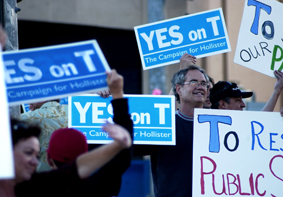
It is distinctly telling that city officials have laid out just one plan regarding the Measure E sales tax proposal. That so-called “austerity plan” would take effect if voters deny the 1 percent extension for five more years and includes a boatload of layoffs, particularly in public safety departments.
That austerity plan was carefully designed by City Manager Clint Quilter – and approved by his disciples on the council in December – as a scare tactic that is now being used as the tax proponents’ one and only message: Approve Measure E or the city will fall off a fiscal cliff and your neighborhoods will become overrun by gangs.
The questions that voters should ask city officials are this: Why is there one simple, looming outlook in the event Measure E fails that does nothing to address the unit cost of government? And why is there no plan in the event it passes – other than to continue on the same, perilous path with no blueprint for a transition once this measure would expire, with not one cent committed to spurring economic development and revenue growth?
Let’s make one thing clear: Whether this measure passes or fails, it is not an endless, money-filled rainbow to cure Hollister’s deep well of financial problems. Have we not learned from Measure T in 2007 – how the economy has shown no signs of a serious turnaround, how we cannot continue spending ourselves into insanity without changing, or blowing up, the course?
When city voters approved Measure T in November 2007 – after desperate pleas from proponents about the need to boost services – Hollister council members approved Quilter-negotiated contracts that immediately increased wages by more than $500,000 that first fiscal year. At the time, they had stated public plans to use about half of the expected revenue on new hires – which itself soon became a pipe dream with the unraveling of the economy and the half-million-dollar annual commitment to current employees.
So much for that pledge for improved services. So much for leadership.
With no choice outside of layoffs, officials received some concessions from the unions as the recession unfolded. But they have done nothing to reduce the overall cost of government to a sustainable level and nothing to contain the unit cost. They have shown an eerie, repetitive unwillingness – at the behest of the unions – to accept reality and take bold steps toward reducing not just the city salaries that are completely out of line with private sector compensation, but even more important, the outrageous health and pension packages that are driving this and other cities toward ruin.
City leadership’s attempt to play the same song on the same broken record defies the logical perspective that any somewhat attentive voter must understand by now: Fool me twice – shame on me. With the November item, they even copied the same text from the 2007 measure – a sign they expect the public to roll over and accept their self-designed pitch of desperation, as occurred five years ago.
It is not as if Hollister leaders weren’t warned. The alarm has been ringing for more than four years, essentially from the point voters bought into the Measure T scam.
It is clear voters cannot count on the notion that the Hollister council learned its lesson, that the unions and city management understand the severity of this crisis and the fantasy world they have experienced for the past decade-plus.
The only certainty after the November election is that four of five current council members will retain seats. There is a mayor’s race, but the mayor is just one of five council members. Hope in a prospective candidate’s leadership is not enough reason to trust an entire council, a culture that continually fails to understand the necessity for promoting business growth and the negative economic impact resulting from a higher sales tax.
Beyond the past five years’ performance and beyond the fact that at least 80 percent of the council will continue calling the shots, here are a few more reasons why the voters should remain skeptical:
There is no official plan on the table for the Measure E money to promote business growth – most poignantly necessary to improve the quality of life for local residents and also, by the way, the only reasonable and affordable way local governments can sustain long-term revenue increases.
Second, the city and unions have made a major mistake by staying quiet on the concession front while holding out hopes they will retain all their jobs and Hollister will continue funding their salaries and benefits at current levels. Taking bold steps leading up to the election to further decrease health and benefit costs – and accepting a significant wage cut – could have gone a long way toward convincing voters they are willing to work toward real compromise in exchange for the sales tax investment from residents.
Finally, there seems to be no intention to put aside any of the expected $3.2 million into reserves. Councilman Ray Friend has individually expressed the need to do so, but nothing is set in stone. Remember, he’s one council member. And other council members, such as Doug Emerson, who is running for mayor, intend to use all of the money toward the existing cost structure.
If city leaders don’t do enough to gain trust from voters by November – and time is running short – the measure will fail and, for once, they would have no choice but to make difficult decisions.









